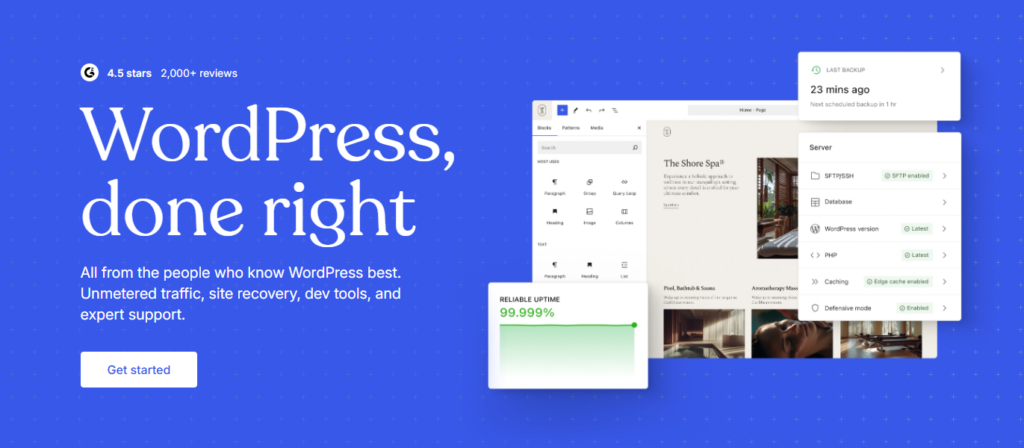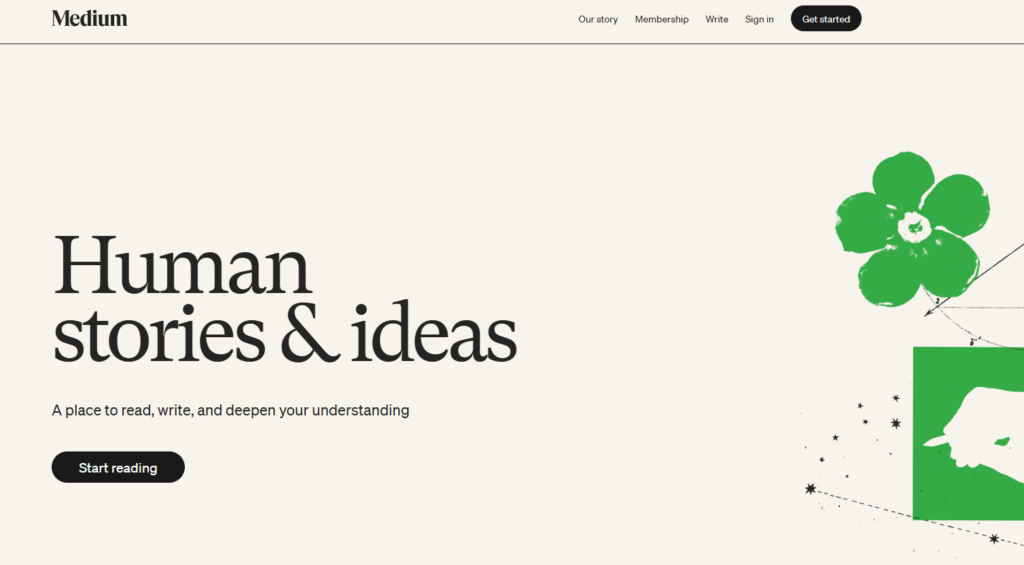Three years ago, I was broke.
Like, checking my bank account multiple times hoping the numbers would magically change kind of broke.
I had this crazy idea to start a blog for free in Canada and somehow turn it into income.
Everyone told me blogging was dead.
“Nobody reads blogs anymore,” they said.
“You need thousands of dollars for hosting, design, and marketing,” they warned.
They were wrong.
Dead wrong.
In 2025, blogging isn’t just alive – it is thriving.
Canadians are consuming more online content than ever, and businesses are desperately searching for authentic voices to connect with local audiences.
The best part?
You can start a blog for free in Canada today and begin generating income within 90 days.
No upfront costs.
No technical degree required.
No need to quit your day job.
I’m going to show you exactly how I did it, and how you can too.
This isn’t another fluffy guide filled with theory.
This is the step-by-step blueprint I wish someone had given me when I started.
What You’ll Need to Start a Blog for Free in Canada
Let’s get one thing straight.
When people say “free,” they usually mean “free until it is not.”
But when I say you can start a blog for free in Canada, I mean completely free.
Zero dollars out of pocket.
Here is what you actually need:
Time Investment
- 2-3 hours for initial setup
- 5-10 hours per week for content creation
- 1-2 hours weekly for promotion and engagement
Most people underestimate the time commitment.
They think they’ll write one post and watch the money roll in.
That is not how this works.
Success requires consistency, and consistency requires realistic expectations.
Read also: 18 Ways to Make Money Writing Online in Canada
Technical Requirements
- Computer or smartphone with internet access
- Email address (preferably Gmail for integration)
- Basic writing skills (grade 8 level is perfect)
- Phone camera for photos and videos
That is it.
No coding knowledge required.
No expensive software needed.
No professional photography equipment necessary.
Canadian-Specific Considerations
Starting a blog in Canada comes with unique advantages and challenges:
Advantages:
- Access to both Canadian and US markets
- Strong dollar purchasing power for digital tools
- Excellent internet infrastructure
- Multicultural audience opportunities
Challenges:
- Tax implications (you’ll need to report blog income to CRA)
- Payment processing limitations with some platforms
- Seasonal traffic patterns
- Competition from established Canadian bloggers
Essential Free Tools List
Here are the tools that won’t cost you a penny:
- Blogging Platform: WordPress.com, Blogger, or Medium
- Image Editing: Canva (free tier)
- Analytics: Google Analytics
- SEO Research: Google Keyword Planner
- Social Media Scheduling: Buffer (free plan)
- Email Marketing: Mailchimp (free for first 2,000 subscribers)
These tools alone would cost you hundreds of dollars monthly if you paid for premium alternatives.
But you don’t need premium when you’re starting out.
Step-by-Step Instructions On How to Start a Blog for Free in Canada
Now, let me take you through the exact steps you need to start a free blog in Canada!
Step 1: Choose Your Niche and Domain
This is where most people mess up.
They choose a niche they think will make money instead of one they actually know about.
Big mistake.
Your niche should be:
- Something you can talk about for hours without getting bored
- A topic with an active Canadian audience
- An area where you have personal experience or expertise
Popular Canadian blog niches that make money:
- Personal finance (especially Canadian tax strategies)
- Canadian travel and outdoor activities
- Home renovation and DIY projects
- Canadian food and recipes
- Small business advice for Canadian entrepreneurs
Once you’ve chosen your niche, you need a domain name.
Free domain options:
- Use your blogging platform’s subdomain (yourname.wordpress.com)
- Get a free .tk domain from Freenom
- Use a free .ca domain if available through promotional offers
Pro tip: Keep your domain name short, memorable, and related to your niche.
Avoid hyphens, numbers, and made-up words.
Warning: Free domains have limitations.
You can’t fully customize them, and they’re harder to brand.
But they are perfect when you are starting out and validating your idea.
Step 2: Select a Free Blogging Platform
You have three main options to start a blog for free in Canada:
WordPress.com (Recommended)

Pros:
- Most professional-looking option
- Excellent SEO capabilities
- Large community and support
- Easy to upgrade later
Cons:
- Limited customization on free plan
- WordPress branding on your site
- No plugins allowed
- Limited monetization options
Blogger

Pros:
- Owned by Google (excellent integration)
- Completely free forever
- No storage limits
- Good for beginners
Cons:
- Limited design options
- Fewer professional features
- Harder to migrate later
- Less community support
Medium

Pros:
- Built-in audience
- Beautiful, clean design
- Great for building authority
- Potential to earn through Medium Partner Program
Cons:
- Limited customization
- You don’t own your audience
- Algorithm-dependent traffic
- Harder to build your own brand
My recommendation?
Start with WordPress.com.
It gives you the best foundation for growth while keeping everything free.
Step 3: Set Up Your Blog
I’m going to walk you through setting up WordPress.com since it’s the best option.
Account Creation Process:
- Go to WordPress.com
- Click “Start your website”
- Choose “Start with a blog”
- Select your free subdomain
- Pick the free plan
- Create your account with a Canadian email address
Theme Selection:
- Choose a responsive theme (mobile-friendly)
- Pick something clean and simple
- Avoid themes with too many features you won’t use
- Popular free themes: Astra, GeneratePress, Neve
Basic Customization:
- Upload a profile photo
- Write a compelling bio
- Create an “About” page
- Set up your menu structure
- Add social media links
Mobile Optimization Tips:
- Preview your site on mobile before publishing
- Keep paragraphs short (2-3 sentences max)
- Use large, easy-to-read fonts
- Ensure buttons and links are finger-friendly
Step 4: Create Your First Content
Content is king.
But in Canada, context is queen.
Your content needs to speak directly to Canadian experiences, challenges, and opportunities.
Content Planning Strategy:
- Research what Canadians are searching for in your niche
- Create a content calendar with 30 post ideas
- Mix educational, entertaining, and promotional content
- Include Canadian-specific examples and case studies
SEO Basics for the Canadian Market:
- Use Canadian spelling (colour, not color)
- Include location-specific keywords
- Reference Canadian laws, regulations, and cultural events
- Optimize for “near me” searches
Publishing Schedule:
- Start with 2-3 posts per week
- Publish consistently (same days, same times)
- Batch create content when possible
- Always have 3-5 posts ready in advance
Remember, when you start a blog for free in Canada, consistency beats perfection every time.
Tips for Success When You Start a Blog for Free in Canada
Success leaves clues.
After analyzing hundreds of successful Canadian bloggers, I’ve identified the patterns that separate winners from wannabes.
#1. Build Your Canadian Network
Connect with other Canadian bloggers:
- Join Canadian blogging Facebook groups
- Attend virtual Canadian marketing events
- Collaborate on guest posts
- Share each other’s content
Engage with your local community:
- Write about local events and businesses
- Partner with Canadian brands
- Join local business associations
- Attend networking events in your city
#2. Master Social Media Integration
Platform priorities for Canadian bloggers:
- Facebook (highest engagement for Canadian content)
- Instagram (great for visual content)
- LinkedIn (B2B and professional content)
- TikTok (growing rapidly among Canadian youth)
- Twitter/X (news and real-time engagement)
Social media tips:
- Share blog content across all platforms
- Adapt content format for each platform
- Use Canadian hashtags and geotags
- Engage with followers consistently
#3, Email List Building Strategy
Email marketing has the highest ROI of any digital marketing channel.
Start building your list from day one.
Free email list building tactics:
- Create lead magnets (free guides, checklists, templates)
- Add opt-in forms to every blog post
- Offer exclusive Canadian content to subscribers
- Run simple giveaways and contests
Canadian email marketing considerations:
- Comply with CASL (Canada’s Anti-Spam Legislation)
- Always get explicit consent before adding people to your list
- Include clear unsubscribe options
- Keep detailed records of consent
When you start a blog for free in Canada, your email list is your most valuable asset.
Social media platforms can disappear overnight.
Your email list belongs to you forever.
Common Mistakes to Avoid When You Start a Blog for Free in Canada
I’ve made every mistake in the book.
Learn from my failures so you can skip straight to success.
Mistake #1: Not understanding free plan restrictions
Free blogging platforms have limits:
- Storage space caps
- Bandwidth restrictions
- Limited customization
- Advertising restrictions
Solution: Read the terms of service carefully and plan for eventual upgrades.
Mistake #2: Building your entire strategy around platform features
What happens when the platform changes their rules?
Solution: Focus on building your audience and brand, not just your platform presence.
Mistake #3: Ignoring tax obligations
The Canada Revenue Agency considers blog income as business income.
Even $1 needs to be reported.
Mistake #4: Violating CASL regulations
Canada’s anti-spam laws are strict.
Violations can result in fines up to $10 million.
Solution: Always get explicit consent for email marketing and keep detailed records.
Mistake #5: Trying to appeal to everyone
“When you speak to everyone, you speak to no one.”
Solution: Define your ideal Canadian reader and write specifically for them.
Mistake #6: Copying American content strategies
What works in the US doesn’t always work in Canada.
Solution: Create Canada-specific content that addresses local challenges and opportunities.
Mistake #7: Trying to monetize too early
You need an audience before you can monetize.
Mistake #8: Relying on a single income stream
Diversification is key to sustainable blog income.
Solution: Build multiple revenue streams:
- Affiliate marketing
- Sponsored content
- Digital products
- Consulting services
- Email marketing
Remember, you can start a blog for free in Canada, but building a profitable blog takes time, patience, and strategic thinking.
Read also: How to Start a Company in Canada: Your Complete Step-by-Step Guide
Troubleshooting Common Issues When You Start a Blog for Free in Canada
Problems are inevitable.
Solutions are what separate successful bloggers from quitters.
Problem: Site loading slowly
Slow sites kill user experience and SEO rankings.
Solutions:
- Optimize images before uploading
- Use fewer plugins and widgets
- Choose a faster theme
- Consider upgrading to a paid plan with better performance
Problem: Mobile display issues
Over 60% of Canadian internet traffic comes from mobile devices.
Solutions:
- Preview every post on mobile before publishing
- Use responsive themes only
- Keep paragraphs short
- Test loading speed on mobile networks
Problem: No one is reading your content
This is the #1 complaint I hear from new bloggers.
Solutions:
- SEO optimization: Research keywords Canadians actually search for
- Social media promotion: Share content consistently across platforms
- Guest posting: Write for established Canadian websites
- Community engagement: Comment on other blogs in your niche
Problem: Traffic from wrong geographic locations
You want Canadian readers, but you’re getting traffic from everywhere except Canada.
Solutions:
- Use Canadian-specific keywords
- Write about Canadian topics and events
- Include your location in your bio and content
- Join Canadian online communities
Problem: Affiliate programs don’t accept Canadians
Many US affiliate programs exclude Canadian applicants.
Solutions:
- Amazon Associates Canada: Lower commissions but accepts Canadians
- Canadian company affiliate programs: Shopify, Canadian Tire, etc.
- Global programs: ShareASale, Commission Junction
- Create your own products: Digital courses, ebooks, consulting
Problem: Payment processing issues
Some platforms don’t support Canadian bank accounts or charge high fees.
Solutions:
- PayPal: Widely accepted, reasonable fees
- Stripe: Excellent for direct payments
- Interac e-Transfer: For Canadian clients
- Wise (formerly TransferWise): Best for international payments
When you start a blog for free in Canada, expect challenges.
The difference between success and failure is how you handle them.
Alternatives to Starting a Blog for Free in Canada
One size doesn’t fit all.
Depending on your goals, timeline, and technical comfort level, you might consider these alternatives.
Self-Hosted WordPress Alternative
When to consider this:
- You’re serious about long-term growth
- You want complete control over your site
- You’re comfortable with slightly more technical setup
- You have $5-10/month for hosting
Advantages:
- Full customization control
- Unlimited monetization options
- Professional appearance
- Better SEO capabilities
Disadvantages:
- Monthly hosting costs
- More technical maintenance required
- Steeper learning curve
- Need to handle backups and security
Recommended Canadian hosting providers:
- HostPapa: Canadian-owned, excellent support
- Web Hosting Canada: Environmentally friendly
- Canadian Web Hosting: Budget-friendly options
Read also: How to Start a Blog and Make Money in Canada
Social Media Blogging
Platforms to consider:
- LinkedIn Articles: Great for B2B content
- Facebook Notes: Declining but still viable
- Instagram captions: Micro-blogging approach
- TikTok: Video-first content strategy
When this works:
- You’re more comfortable with social media than websites
- Your audience is primarily on one platform
- You prefer video or visual content over written posts
- You want to test content ideas before creating a full blog
Newsletter Platforms
Top options:
- Substack: Built-in monetization features
- ConvertKit: Excellent automation tools
- Mailchimp: Free for up to 2,000 subscribers
- Beehiiv: Growing platform with good features
When to choose newsletters over blogs:
- You want direct audience relationships
- Email marketing is your primary strategy
- You prefer longer-form, less frequent content
- You want to monetize through subscriptions
When to Upgrade from Free
Signs it’s time to invest in paid options:
- You’re consistently publishing 2+ posts per week
- You’re generating any income from your blog
- You’ve hit storage or bandwidth limits
- You want to remove platform branding
- You need advanced SEO or analytics features
Upgrade path:
- Month 1-3: Free platform to validate your idea
- Month 3-6: Upgrade to paid plan on same platform
- Month 6-12: Consider self-hosted WordPress
- Year 1+: Invest in professional design and advanced tools
The key is to start where you are with what you have.
You can always upgrade later once you’re generating income.
When you start a blog for free in Canada, focus on creating value first, then worry about advanced features.
Final Thoughts
Here is what I want you to remember.
Three years ago, I was checking my bank account hoping for a miracle.
Today, my blog generates enough income to cover my mortgage.
Not because I’m special.
Not because I had some secret advantage.
But because I took action when everyone else made excuses.
You can start a blog for free in Canada today.
Right now.
This moment.
You have everything you need:
- Free blogging platforms
- Proven strategies
- A step-by-step blueprint
- Access to Canadian audiences hungry for authentic content
The only question is: Will you start?
Or will you join the majority who read articles like this, bookmark them, and never take action?
Your next steps:
- Choose your niche today
- Set up your free WordPress.com account this week
- Publish your first post within 7 days
- Create a publishing schedule and stick to it
- Connect with other Canadian bloggers in your niche
Success isn’t guaranteed.
But failure is certain if you never start.
The best time to start a blog for free in Canada was yesterday.
The second-best time is right now.
What are you waiting for?
Frequently Asked Questions
How long does it take to make money blogging in Canada?
Most successful Canadian bloggers start seeing income between months 3-6, with significant revenue typically developing after 12-18 months of consistent effort. Your timeline depends on your niche, content quality, and promotion strategy.
Do I need to register my blog as a business in Canada?
You don’t need to register initially, but once you start earning income, you’ll need to report it to the CRA. Consider registering for GST/HST if you expect to earn over $30,000 annually.
Can I use American affiliate programs if I start a blog for free in Canada?
Some American affiliate programs accept Canadian bloggers, but many don’t. Focus on Amazon Associates Canada, Canadian company programs, and international networks like ShareASale or Commission Junction.
What’s the difference between WordPress.com and WordPress.org for Canadian bloggers?
WordPress.com is hosted for you (easier but limited), while WordPress.org requires you to find hosting (more control but more technical). Start with WordPress.com and upgrade to WordPress.org when you’re ready for more control.
How do Canadian privacy laws affect my blog?
You must comply with PIPEDA (Personal Information Protection and Electronic Documents Act) and CASL (Canada’s Anti-Spam Legislation). Always get explicit consent for email marketing and clearly state how you collect and use personal information.
Should I write in English or French for my Canadian blog?
This depends on your target audience. English reaches a broader Canadian audience, but French content can be less competitive in Quebec markets. Consider your niche and local demographics when deciding.
How much time should I spend promoting vs. creating content?
Follow the 80/20 rule: spend 20% of your time creating content and 80% promoting it. Most new bloggers do the opposite and wonder why no one reads their posts.
 cPanel Web HostingAffordable Canadian cPanel hosting, user-friendly and reliable.
cPanel Web HostingAffordable Canadian cPanel hosting, user-friendly and reliable. Reseller HostingStart your own hosting business with flexible reseller hosting plans.
Reseller HostingStart your own hosting business with flexible reseller hosting plans. Affiliate ProgramJoin our affiliate program and earn commissions by referring customers.
Affiliate ProgramJoin our affiliate program and earn commissions by referring customers. DomainsFind the perfect domain for your business or personal site with ease.
DomainsFind the perfect domain for your business or personal site with ease. Domain TransferTransfer your domain to us and keep your website running without interruption.
Domain TransferTransfer your domain to us and keep your website running without interruption. WHOIS LookupQuickly find who owns a domain with our easy WHOIS search tool.
WHOIS LookupQuickly find who owns a domain with our easy WHOIS search tool. VPS HostingReliable VPS hosting crafted for performance and peace of mind.
VPS HostingReliable VPS hosting crafted for performance and peace of mind.
